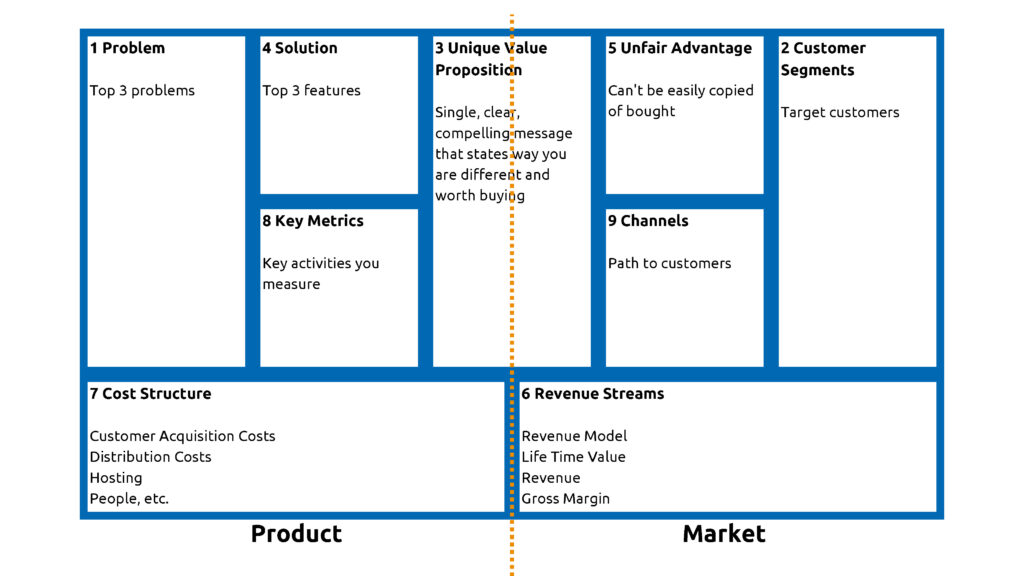
What is scaling up?
Scaling up means deploying solutions on a larger scale. In this way, the solutions provide more benefits. According to lean startup approach, phases of a successful startup are:
- Problem/solution fit: Find out whether there is a problem that is worth solving, that customers are willing to pay to be solved, and that can be feasibly solved. Validate the problem and the solution with real potential customers and end-users.
- Product/market fit: Test the solution and its ability to solve the problem with a minimum viable product (MVP). The MVP includes a minimal set of features for solving the core problem.
- Scale: Build organisational structures, turn startup into a corporation.
Preparations for scaling up: scalable business model
A business model describes how a company creates and delivers value to its customers and captures a market share so that the business model becomes economically sustainable. The business model can be presented using the Lean Canvas.
The elements of the Lean Canvas are described in the following tool (> Tool 5). You can use the tool for thinking about the answers, and after that, collect your answers on the Lean canvas (see figure).
Lean Canvas - point 1: Understanding the customer problem
Startups fail if they are not able to create a sufficient understanding of customers and their problem to build a solution that is wanted by the market. A minimum viable product (MVP) is built and re-built for the purpose of learning as much as possible and continuously improving the product.
Lean Canvas - point 2: Who is the customer?
Defining the right customer segments is not always easy in the AHA sector. Is it the doctor, the hospital, the municipality, the elderly end-user, the family member, the insurance company, or someone else? It is important for the innovator to engage with stakeholder communities and find out what they want.
The (paying) customers of the solution in the AHA sector could be:
- Seniors (Which specific age groups and physical or mental characteristics?)
- Families (Informal caregivers, who specifically?)
- Private organisations providing services to seniors (Which specifically?)
- Public organisations providing services to seniors (Which specifically?)
- Local government (Which specifically?)
- Regional government (Which specifically?)
- National government (Which specifically?)
- Insurance companies (Which specifically?)
- Others (who/which?)
The end-users of the solution in the AHA sector could be:
- Seniors (Which specific age groups and physical or mental characteristics?)
- Professionals (Formal caregivers, doctors, nurses, researchers; who specifically?)
- Families (informal caregivers, who specifically?)
- Private organisations providing services to seniors (Which specifically?)
- Public organisations providing services to seniors (Which specifically?)
- Others (who/which)?
Besides end-users and customers, other key stakeholders to approach should be considered. Depending on the situation, they can include national, regional, or local decision makers, or NGOs advocating necessary policy changes.
Lean Canvas - point 3: Unique value proposition
A unique value proposition should be short and explain how the solution is different and why that difference matters. To succeed, an idea must be desirable, viable, and feasible.
Lean Canvas - point 4: Solution - is the innovation scalable?
For being easily scalable, the innovation should be credible (tested), observable, relevant, better than existing practices, easy to understand, compatible, and testable without complete adoption. In addition, the technological implementation should be easy to scale (software, cloud, etc.) and the solution should be based on person-centred care (PCC) principles.
Before attempting to scale up, the scalability of the innovation should also be assessed. You can use the following tool to assess the scalability of the innovation (> Tool 6) and think about how to improve scalability with this tool (> Tool 7).
Lean Canvas - point 5: Solution - Unfair advantage
Examples of unfair advantage include insider information, dream team, personal authority, network effects, community, existing customers and their loyalty.
Lean Canvas - points 6 and 7: Revenue and costs
There are various revenue and pricing models to try. There are some that come with a one-time license fee and others that are subscription-based. Defining the costs and cost structure means defining which costs are variable and fixed costs. The usual advice for a startup is that it is best to keep fixed costs to the minimum.
Lean Canvas - point 8: Channels - how is the solution integrated into the larger service delivery system?
Ecosystem thinking is essential for planning the integration of the solution into the bigger service delivery system – for example, a homecare system, a care home’s elderly care system, a hospital’s treatment system or associated ICT system.
Lean Canvas - point 9: Metrics
Metrics are used to help a company improve and focus on essential issues. Without metrics it is hard to reach goals and measure progress.
You can read more about how to use the Lean Canvas from the complete version of the playbook (pages 41-49) here.
How to scale up?
The following principles can help in the development of a scale-up strategy:
- Ecosystems thinking – Being aware that the scale-up of innovations is carried out in a complex network of relations and systems.
- Building on sustainability – Taking into account regulations, policies, guidelines, budgets and health and care systems and their reforms, and aligning innovations and scaling up with them.
- Enhancing scalability – Taking scale-up into consideration already at early stages.
- Participatory approach and person-centredness – Scaling up should be guided by participatory and person-centred approaches.
- Testing at all stages – Testing activities continue throughout the development and scale-up process, however, the object of testing and with whom the testing is carried out change.
- When developing a scale-up strategy, the questions of why, what and how to scale up must be answered – You can think about these issues with the help of the following tool (> Tool 8).
Challenges of scaling up
Read about some of the challenges of scaling up that the IN-4-AHA pilot companies have faced from the complete version of the playbook (pages 58-60) here.
Market logics and market information: How to approach new markets abroad?
There are several useful frameworks for analysing the macroeconomic environment. One of the most used is PEST analysis in its various forms.
The health and care industries are infamous for their bureaucracy and long sales cycles. The regulatory environment is complex and there are multiple levels – international, national, regional.
There are several reasons why scaling up may fail. The main reason is a lack of demand: if a startup wants to solve a problem that seems interesting, but it is not big enough to require a general solution (not desirable). Similarly, a startup may identify a relevant problem, but its technology cannot solve it (not feasible). Or the business model cannot solve it in an economically sound and scalable way (not viable). In addition to these, there are several other reasons, for example insufficient networking and marketing.
References can be found in the complete version of the playbook (pages 70-78) here.
